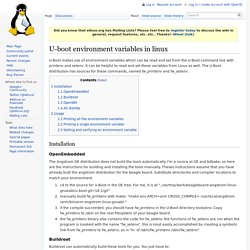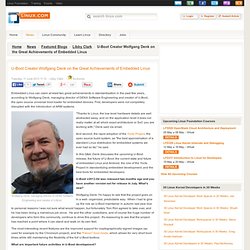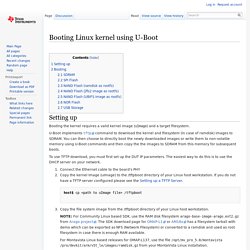

Wiki - U-boot. Bootm <Linux uImage address><mkimage wrapped ramdisk address><device tree (dtb) address> u-boot> fatload mmc 0 0x3000000 uImage u-boot> fatload mmc 0 0x2A00000 devicetree.dtb u-boot> fatload mmc 0 0x2000000 uramdisk.image.gz u-boot> bootm 0x3000000 0x2000000 0x2A00000 ?

Xilinx/u-boot-xlnx. BeagleBoard. U-boot environment variables in linux. U-Boot makes use of environment variables which can be read and set from the U-Boot command line with printenv and setenv.

It can be helpful to read and set these variables from Linux as well. The U-Boot distribution has sources for these commands, named fw_printenv and fw_setenv. Installation OpenEmbedded The Angstrom OE distribution does not build the tools automatically. Cd to the source for U-Boot in the OE tree. Buildroot Buildroot can automatically build these tools for you. Make menuconfig and then select the following option: Target filesystem options ---> [*] Das U-Boot Boot Monitor ---> [*] fw_printenv tool in target Tools will be installed in /usr/sbin/ of your target's rootfs. OpenWrt Like Buildroot, OpenWrt can build these tools too but you will find them in a different location in the menu: Utilities ---> [*] uboot-envtools Tools will also be installed in /usr/sbin/.
All distribs The last and most important step is creating the config file for the utilities. Usage WARNING! Git.denx.de Git - u-boot.git/summary. Manual < DULG < DENX. Beagle.s3.amazonaws.com/esc/Uboot-esc-chicago-2010.pdf. U-Boot Creator Wolfgang Denk on the Great Achievements of Embedded Linux. Embedded Linux can claim at least two great achievements in standardization in the past few years, according to Wolfgang Denk, managing director of DENX Software Engineering and creator of U-Boot, the open source universal boot loader for embedded devices.

First, developers were not completely disrupted with the introduction of ARM systems. Wolfgang Denk, managing director of DENX Software Engineering and creator of U-Boot. "Thanks to Linux, the low level hardware details are well abstracted away, and on the application level it does not really matter at all which exact architecture or SoC you are working with," Denk said via email.
And second, the rapid adoption of the Yocto Project, the open source build system, as "the best approximation of a standard Linux distribution for embedded systems we ever had so far," he said. U-Boot v2013.04 was released two months ago and you have another version set for release in July. What are important future activities in U-Boot development?
Booting Linux kernel using U-Boot. Booting the kernel requires a valid kernel image (uImage) and a target filesystem.

U-Boot implements tftp command to download the kernel and filesystem (in case of ramdisk) images to SDRAM. You can then choose to directly boot the newly downloaded images or write them to non-volatile memory using U-Boot commands and then copy the the images to SDRAM from this memory for subsequent boots. To use TFTP download, you must first set up the DUT IP parameters. The easiest way to do this is to use the DHCP server on your network. Connect the Ethernet cable to the board's PHYCopy the kernel Image (uImage) to the /tftpboot directory of your Linux host workstation.
Host$ cp <path to uImage file> /tftpboot Copy the file system image from the /tftpboot directory of your Linux host workstation. NOTE: For Community Linux based SDK, use the RAM disk filesystem arago-base-image-arago.ext2.gz from Arago project. Host$ cp <path to ramdisk file> /tftpboot Setup the EVM IP address. Use static IP address SPI Flash.